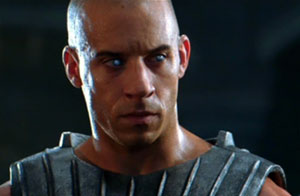
Baker Pitts, Guest Writer
Part One
Do you like feel good comedies that have you leaving the theater with a warm feeling down in your tummy? If you answered yes to that question, then you probably should not go see Riddick.
Riddick is the story of a muscled guy who can see in the dark and is simply trying to find his way home. Along the way he is confronted by two groups of mercenaries that want the bounty on his head. He is then forced to get off the planet no matter what is in his way or who he has to kill.
Riddick is visually impressive, with beautiful landscapes and incredibly cool looking creatures, but unfortunately, that is where the impressiveness ends. The storytelling is shoddy and driven almost entirely by violence, and if you want character development, then you would be better off watching Pacific Rim or a Godzilla movie from the 80s. Now, I do not really have an issue with violence in movies, but the violence portrayed in Riddick serves little purpose beyond simply showing violence.
All in all, I would not recommend going to see Riddick if you have any interest in seeing a movie that will keep you interested, excited or if you are expecting to have any fun at all at the movies. Also, since this is my first review, I’m going to set a precedent of including a trigger warning at the end of my articles to give warnings of things that you will find in reviewed movies.
TRIGGER WARNING: Extreme blood and gore, nudity, attempted rape, potty mouths.
Part Two
Samuel Duce, Staff Writer
Writer/Director David Twohy’s Riddick has not had a bad reception. It debuted as the highest grossing film in North America and was more defended than criticized by the popular press. Charles Koplinski of the Illinois Times called it “a Bit of B-Movie Heaven,” and the majority of favorable reviews towards the film more or less reiterates this summation. It has not been defended by any other standard.
According to the Oxford Dictionary, a B-Movie is “a low-budget movie, esp. (formerly) one made for use as a companion to the main attraction in a double feature.” These films are intentionally campy and cheap, yet assert cleverness for their ability to be this way effectively and stylishly. Riddick is an example of a film that incorporates the exploitative and vulgar aspects of the B-movie genre, yet fails to exhibit an essential self-awareness. It therefore cannot be categorized in this genre.
In the film, after being betrayed by his people, the outlaw titular character is stranded on a planet and is forced to grapple with its hostile natural inhabitants. When he senses impending danger, he sends a distress signal resulting in a team of bounty hunters seeking his capture. He kills them at whim until they are forced to band together in order to escape the planet and its murderous alien creatures.
Twohy seems uninterested in this premise to the extent that the backstory of his betrayal is almost incomprehensible due to its hurriedness as well as lack of context, and each character is a rudimentary stereotype. He is more interested in providing baseless spectacles of sexism and ultra-violence.
Violence is depicted with thoughtlessness, such as in the death of a particular bounty hunter. Riddick cuts his head in half and it is shown sliding in two. Though this act is exaggerated to the point of spectacle as in the B-movie genre, it does not achieve the comic tone typically used. It is instead used as an affirmation to the repeated sentiment in the film that Riddick is a tough dude. Is the audience supposed to admire him for his banal cruelty?
Though the original B-movie films were likely admired and studied by the filmmakers who originally recreated them in tribute, the general viewing public is undoubtedly more familiar with the genre that has developed rather than the original films from which they gained inspiration. Modern filmmakers, too, seem recently more inspired by the modern genre than the original films, resulting in a gradual distillation of the same tropes. As inspiration is passed on, context is often lost and the meanings of these tropes may be inadvertently lost. Such is the case with this film. Twohy seems unaware how he intends the viewer to interpret the depictions of violence and sexuality.
These qualities of poor craft without awareness of implications suggest that the film is much more similar to an original B-movie than the post-modern genre in its tribute. What distinguishes it even from this is its large budget. If its quality is not defensible by even this standard then in what way is it defensible?